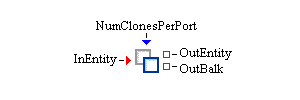Templates

The Clone block creates clones of entities that pass through it. A clone is a new entity with the same type and all of the same attributes as the original entity. When an entity enters a Clone block, the block first determines whether anything is connected to its NumClonesPerPort port. If it finds a connection, the Clone block attempts to pull a value from the NumClonesPerPort port. This value represents the number of clones of the original entity that the Clone block generates for each clone output port. If this value is greater than 1, multiple clones flow sequentially out of each clone output port.
If there are no connections to the NumClonesPerPort port, the Clone block uses the value specified in its ClonesPerPort properties dialog box field for the number of clones to generate per clone output port.
You can set the number of clone output ports in the properties dialog box. If no clone output ports exist, the new clone entities are pushed through the OutEntity port. The original entity is always the first entity to exit the Clone block, and it exits via the OutEntity port. If the original entity or a clone cannot be accepted downstream, it flows out through the OutBalk port.
- InEntity
-
Input entity port for entities to enter the Clone block.
- OutEntity
-
Output entity port for the input entity if it can be accepted by a downstream block. If there are no clone output ports, clone entities that can be accepted by a downstream block also go out through this port.
- OutBalk
-
Output entity port for any entities that cannot be accepted by a downstream block.
- NumClonesPerPort
-
Input integer port for the number of clone entities for the clone block to generate for each clone output port.
- Clones Per Port
-
Specifies how many clones are generated for each clone output port. This value is used only if there are no connections to the NumClonesPerPort port.
- Cloning Ports
-
Specifies how many clone output ports are available on this block.